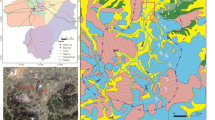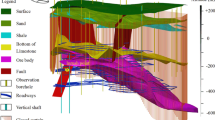Abstract
In 1996, a grout curtain was constructed in the Zhangmatun Iron Mine near Jinan City, China, which is subject to large groundwater inflows, to decrease the water volume rushing into the mine workings. However, water inflow has recently been increasing in the southwestern area through a seepage channel, which has resulted from the failure of the grout curtain. To understand how the seepage channel formed, the microseismic (MS) activities located in this area were studied and a numerical model was supplementarily used to analyze the damage zone. It is found that the seepage channel formation process is significantly affected by the distance between mining activities and the grout curtain. Mining activities periodically approached and retreated from the southwest grout curtain, causing periodically active and inactive microseismicity, and eventually the grout curtain failure. The damage zone in the grout curtain obtained from the numerical analysis coincides with the seepage channel, especially in the area where the distance between the grout curtain and excavation is less than 35 m. Therefore, the combination of MS monitoring and numerical analysis of damage zones can provide us with an overall understanding of the formation process and causes of the seepage channel.










Similar content being viewed by others
References
Cai M, Morioka H, Kaiser PK, Tasaka Y, Kurose H, Minami M, Maejima T (2007) Back-analysis of rock mass strength parameters using AE monitoring data. Int J Rock Mech Min 44:538–549. doi:10.1016/j.ijrmms.2006.09.012
Han WW, Li SC, Zhang QS, Zhang X, Liu R, Zhang WJ (2013) A comprehensive analysis method for searching weak zones of grouting curtain in mines. Chin J Rock Mech Eng 32:512–519 (in Chinese)
He K, Wang R, Jiang W (2012) Groundwater inrush channel detection and curtain grouting of the Gaoyang iron ore mine, China. Mine Water Environ 31:297–306. doi:10.1007/s10230-012-0207-3
Lebert F, Bernardie S, Mainsant G (2011) Hydroacoustic monitoring of a salt cavity: an analysis of precursory events of the collapse. Nat Hazards Earth Syst Sci 11:2663–2675. doi:10.5194/nhess-11-2663-2011
Li Z, Guo D, Wang Y, Zhen Z (2011) Technology research of large underwater ultra-deep curtain grouting in Zhong-guan iron ore. Procedia Eng 26:731–737. doi:10.1016/j.proeng.2011.11.2230
Lu CP, Dou LM, Zhang N, Xue JH, Wang XN, Liu H, Zhang JW (2013) Microseismic frequency-spectrum evolutionary rule of rockburst triggered by roof fall. Int J Rock Mech Min 64:6–16. doi:10.1016/j.ijrmms.2013.08.022
Mendecki AJ (1997) Seismic monitoring in mines. Chapman & Hall, London
Occhiena C, Pirulli M, Scavia C (2014) A microseismic-based procedure for the detection of rock slope instabilities. Int J Rock Mech Min 69:67–79. doi:10.1016/j.ijrmms.2014.02.020
Srinivasan C, Arora SK, Benady S (1999) Precursory monitoring of impending rockbursts in Kolar gold mines from microseismic emissions at deeper levels. Int J Rock Mech Min 36:941–948. doi:10.1016/s0148-9062(99)00048-0
Trifu CI, Shumila V (2010) Microseismic monitoring of a controlled collapse in Field II at Ocnele Mari, Romania. Pure Appl Geophys 167:27–42. doi:10.1007/s00024-009-0013-4
Xu NW, Dai F, Liang ZZ, Zhou Z, Sha C, Tang CA (2013) The dynamic evaluation of rock slope stability considering the effects of microseismic damage. Rock Mech Rock Eng 47:621–642. doi:10.1007/s00603-013-0432-5
Yang TH, Liu J, Zhu WC, Elsworth D, Tham LG, Tang CA (2007a) A coupled flow-stress-damage model for groundwater outbursts from an underlying aquifer into mining excavations. Int J Rock Mech Min 44:87–97. doi:10.1016/j.ijrmms.2006.04.012
Yang TH, Tang CA, Tan ZH, Zhu WC, Feng QY (2007b) State of the art of inrush models in rock mass failure and developing trend for prediction and forecast of groundwater inrush. Chin J Rock Mech Eng 2:268–277 (in Chinese)
Zhang SJ (2008) Research on the stability and monitoring method for grouting curtain under high seepage-pressure. Dissertation, Northeastern University
Zhu WC, Wei CH (2010) Numerical simulation on mining-induced water inrushes related to geologic structures using a damage-based hydromechanical model. Environ Earth Sci 62:43–54. doi:10.1007/s12665-010-0494-6
Acknowledgments
This work was supported by the Basic Research Program (973) of China (No. 2013CB227902) and the National Natural Science Foundation of China (No. 51574059, No. 51574060). The authors thank Tang Chun’an in Northeastern University and Feng Yingjun in Jinan Gangcheng Mine Co., Ltd., for their helpful guide and opinions. Thanks are also extended to the authors of the references cited in this review for their original contributions.
Author information
Authors and Affiliations
Corresponding author
Rights and permissions
About this article
Cite this article
Zhang, P., Yang, T., Yu, Q. et al. Study of a Seepage Channel Formation Using the Combination of Microseismic Monitoring Technique and Numerical Method in Zhangmatun Iron Mine. Rock Mech Rock Eng 49, 3699–3708 (2016). https://doi.org/10.1007/s00603-016-1007-z
Received:
Accepted:
Published:
Issue Date:
DOI: https://doi.org/10.1007/s00603-016-1007-z




